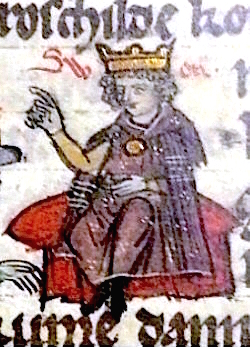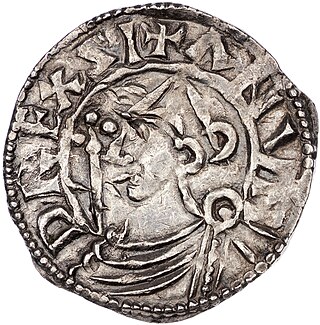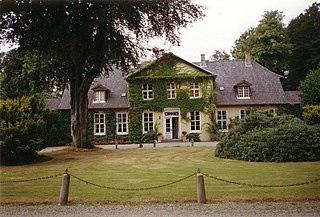
Hedeby was an important Danish Viking Age trading settlement near the southern end of the Jutland Peninsula, now in the Schleswig-Flensburg district of Schleswig-Holstein, Germany. Around 965, chronicler Abraham ben Jacob visited Hedeby and described it as, "a very large city at the very end of the world's ocean."
Truso was a Viking Age port of trade (emporium) set up by the Scandinavians at the banks of the Nogat delta branch of the Vistula River, close to a bay, where it emptied into the shallow and brackish Vistula Lagoon. This sizeable lagoon is separated from the Gdańsk Bay by the Vistula Spit at the southern Baltic Sea coast. In the 9th century, the merchant Wulfstan of Hedeby travelled to Truso in the service of the English King Alfred the Great and wrote his account of the place at a prominent location of the Amber Road, which attracted merchants from central and southern Europe, who supplied the markets in the Mediterranean and the Middle East with the highly valued commodity.

The Duchy of Schleswig was a duchy in Southern Jutland covering the area between about 60 km north and 70 km (45 mi) south of the current border between Germany and Denmark. The territory has been divided between the two countries since 1920, with Northern Schleswig in Denmark and Southern Schleswig in Germany. The region is also called Sleswick in English.

Harald Sigurdsson, also known as Harald III of Norway and given the epithet Hardrada in the sagas, was King of Norway from 1046 to 1066. Additionally, he unsuccessfully claimed both the Danish throne until 1064 and the English throne in 1066. Before becoming king, Harald had spent around fifteen years in exile as a mercenary and military commander in Kievan Rus' and as a chief of the Varangian Guard in the Byzantine Empire. In his chronicle, Adam of Bremen called him the "Thunderbolt of the North".

Olaf Tryggvason was King of Norway from 995 to 1000. He was the son of Tryggvi Olafsson, king of Viken, and, according to later sagas, the great-grandson of Harald Fairhair, first King of Norway. He is numbered as Olaf I.

Magnus Olafsson, better known as Magnus the Good, was King of Norway from 1035 and King of Denmark from 1042 until his death in 1047.

Olaf II Haraldsson, also Olav Haraldsson, later known as Saint Olaf and Olaf the Holy, was King of Norway from 1015 to 1028. Son of Harald Grenske, a petty king in Vestfold, Norway, he was posthumously given the title Rex Perpetuus Norvegiae and canonised at Nidaros (Trondheim) by Bishop Grimketel, one year after his death in the Battle of Stiklestad on 29 July 1030. His remains were enshrined in Nidaros Cathedral, built over his burial site. His sainthood encouraged the widespread adoption of Christianity by Scandinavia's Vikings/Norsemen.

Olaf III or Olaf Haraldsson, known as Olaf the Peaceful, was King of Norway from 1067 until his death in 1093.

Valdemar I Knudsen, also known as Valdemar the Great, was King of Denmark from 1154 until his death in 1182. The reign of King Valdemar I saw the rise of Denmark, which reached its medieval zenith under his son King Valdemar II.

Sweyn Estridsson Ulfsson was King of Denmark from 1047 until his death in 1076. He was the son of Ulf Thorgilsson and Estrid Svendsdatter, and the grandson of Sweyn Forkbeard through his mother's line. He was married at least two times, and fathered 20 children or more out of wedlock, including the five future kings Harald Hen, Canute the Saint, Oluf Hunger, Eric Evergood, and Niels.

Sweyn III Grathe was the king of Denmark between 1146 and 1157, in shifting alliances with Canute V and his own cousin Valdemar I. In 1157, the three agreed to a tripartition of Denmark. Sweyn attempted to kill his rivals at the peace banquet, and was subsequently defeated by Valdemar I at the Battle of Grathe Heath and killed.

The Battle of Stiklestad in 1030 is one of the most famous battles in the history of Norway. In this battle, King Olaf II of Norway was killed. During the pontificate of Pope Alexander III, the Roman Catholic Church declared Olaf a saint in 1164.

Anund Jacob or James was King of Sweden from 1022 until around 1050. He is believed to have been born on 25 July, in either 1008 or 1010 as Jakob, the son of King Olof Skötkonung and Queen Estrid. Being the second Christian king of the Swedish realm, his long and partly turbulent reign saw the increasing dissemination of Christianity as well as repeated attempts to influence the balance of power in Scandinavia. Throughout his reign, he tried to subvert the rising Danish hegemony in Scandinavia by supporting the Norwegian monarchy. He also supported the reign of Yaroslav the Wise in Kievan Rus, his brother-in-law. He is referred to in positive terms in German and Norse historical sources. His reign was one of the longest in Sweden during the Viking Age and Middle Ages.
Magnus V was a king of Norway during the civil war era in Norway. He was the first known Scandinavian monarch to be crowned in Scandinavia. He helped to establish primogeniture in royal succession in Norway. King Magnus was killed in the Battle of Fimreite in 1184 against the forces of Sverre Sigurdsson who became King of Norway.
The Military timeline of Denmark is centered around an involvement in wars in Northern Europe since 793 and, recently, elsewhere.

The Kongeå is a watercourse in Southern Jutland in Jutland, Denmark. It rises southeast of Vejen and Vamdrup and after about 50 kilometres (31 mi) it flows through a sluice to tidal mudflats and sandbanks north of Ribe, and eventually into the North Sea. The eastern section is little more than a stream, while the western section is navigable by boat as far as the sluice. The Kongeå, however, passes no port or market town of any significance, and small boats use the Ribe Å.

Lürschau is a municipality in the district of Schleswig-Flensburg, in Schleswig-Holstein, Germany.

Olav Engelbrektsson was the 28th Archbishop of Norway from 1523 to 1537, the Regent of Norway from 1533 to 1537, a member and later president of the Riksråd, and a member of the Norwegian nobility. He was the last Roman Catholic to be the Archbishop of Norway before he fled to exile in 1537.

The North Sea Empire, also known as the Anglo-Scandinavian Empire, was the personal union of the kingdoms of England, Denmark and Norway for most of the period between 1013 and 1042 towards the end of the Viking Age. This ephemeral Norse-ruled empire was a thalassocracy, its components only connected by and dependent upon the sea.

The Danish Civil Wars were a series of civil wars fought in the Kingdom of Denmark, first from 1131 to 1134 over the murder of Canute Lavard, then from 1139 to 1143, and finally a war of succession fought from 1146 to 1157, after the abdication of Eric III of Denmark, the first monarch in Danish history to have abdicated. The first phase of the war was fought between King Eric II of Denmark and King Niels joined by Magnus the Strong. The second phase of the war was fought between the son of Magnus the Strong, Canute V of Denmark, the son of Eric II of Denmark, Sweyn III of Denmark, and his cousin Valdemar I of Denmark, son of Canute Lavard. The civil wars marked an increase in the influence of the Holy Roman Empire in Denmark, and for a time after, Denmark was a vassal state of Emperor Frederick I. The war ended with the deaths of seven kings. Two of the kings, Olaf Haraldsen and Magnus the Strong, are not amongst the official Danish line of kings. The other kings are Niels I, Eric II, Eric III, Canute V and Sweyn III.

















